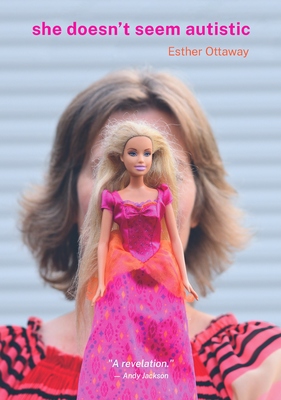 Reviewed by Magdalena Ball
Reviewed by Magdalena Ball
She Doesn’t Seem Autistic
By Esther Ottaway
Puncher & Wattmann
ISBN: 9781922571762, June 2023, Paperback, $25
It doesn’t seem possible that in 2023 and with 1 in 36 children being diagnosed with autism that we still understand so little about it, especially in females. Esther Ottaway’s latest poetry book, She Doesn’t Seem Autistic, is as good a primer as you’ll find on the emotional toil that comes with being an autistic female. The work is clinical in its approach, drawing on experience from a range of autistic women and girls including Ottaway and her daughter. Each poem references a typology of clinical conditions. Ottaway explores the way that women are often taught to mask emotions which can make diagnosis difficult. The book is also deeply personal, putting the reader directly into the experience and incorporating a welter of complex emotions, sensations, and perspectives that are powerful. Poetry is the right medium, embracing the complexity through rhythm, structure, imagery, and an engagement in the senses that creates immediacy.
Nearly three-quarters of autistic children are diagnosed with a co-occuring condition, and Ottaway explores the conjunction, with most of the poem titles containing a co-occuring condition as subtitle. The book opens with a negation “After writing a book on female autism, I decide to bury it”, written in collaboration with the poet Andy Jackson. These four couplets set the tone for the book, connecting the work that follows to the striking cover of a Barbie doll covering a human face. The book explores this masking or “curated pretence” in many ways, working between presentation and revelation:
Truth-pregnant, I laboured. Her name is Repercussions.
My fear: that this child kicks, draws breath to cry.
The perspective is often formal, working from textbook definitely definition through experience. Ottaway often invokes animals: seahorses, giraffes, hermit crabs, horses and caterpillars, many functioning as analogues to the human experience that work through poetic constraints, conceits and analogies:
Happy to be doing this activity with you, while I get worse from doing it. Do you know how I split my face and head off, wrest it free of my distressed body, reattach it with filament, make it smile? Do you know how this unstitching dichotomy, this severing of wellness from happiness is done in the psyche’s inky cocoon? (“The head-stacking caterpillar answers the question how are you?”)
Ottaway uses form in precise ways, allowing rhyme and structure to create an innate irony through repetition, or as in the many villanelles in this collection, creating a false levity to invoke the duality between the outer and inner worlds:
You’re clearly well, don’t waste the doctor’s time.
Autistics do not look the way you do.
A Woman wearing makeup must be fine.
There’s no disabled girls with style like mine. (“There’s no disabled girls with style like mine”)
While sticking to the form, Ottaway plays with her villanelles, creating the “Stillanelle”, the “Illanelle”, and the “Billanelle”, with changes to the repeated lines, and off-rhymes that contrast the intensity of experience with sing-song rhythm:
I did some casual work – the pay’s still owing;
I couldn’t send the bill (anxiety).
My mental health? The camel’s back is bowing. (“Billanelle”)
Several poems make use of anaphora (repetition of first words) in a way that almost feels like stimming – repetitive body movements or sounds sometimes to reduce anxiety or decrease a sensory overload. This technique not only creates a sense of underlying anxiety but helps create a focus on repetition and sound over semantics:
draw attention
draw a blank
draw fire
drawing board (“Female autism diagnostic journey”)
Though many of the poems focus on the lived experience of autism, some also engage with parenting an autistic daughter and the ways in which that maternal experience, something Ottaway has written about in her previous two books, Intimate, low-voiced, delicate things and Blood Universe, moves between anxiety, pride and caring:
And it still is ready, my darling,
As you sit now at the tipping point of those years
And the next eighteen, of loves, and loves lost, perhaps of children. (“Now you are eighteen”)
I don’t think I have read anything quite like She Doesn’t Seem Autistic. The book is both poetically powerful, evoking a visceral sense of familiarity and empathy, and informative, providing a detailed catalogue of many conditions that can often come with autism, like echolalia, empathy overarousal, ADHD, Ehler-Danlos, dyspraxia, dysphoria, and situational mutism, to name a few.